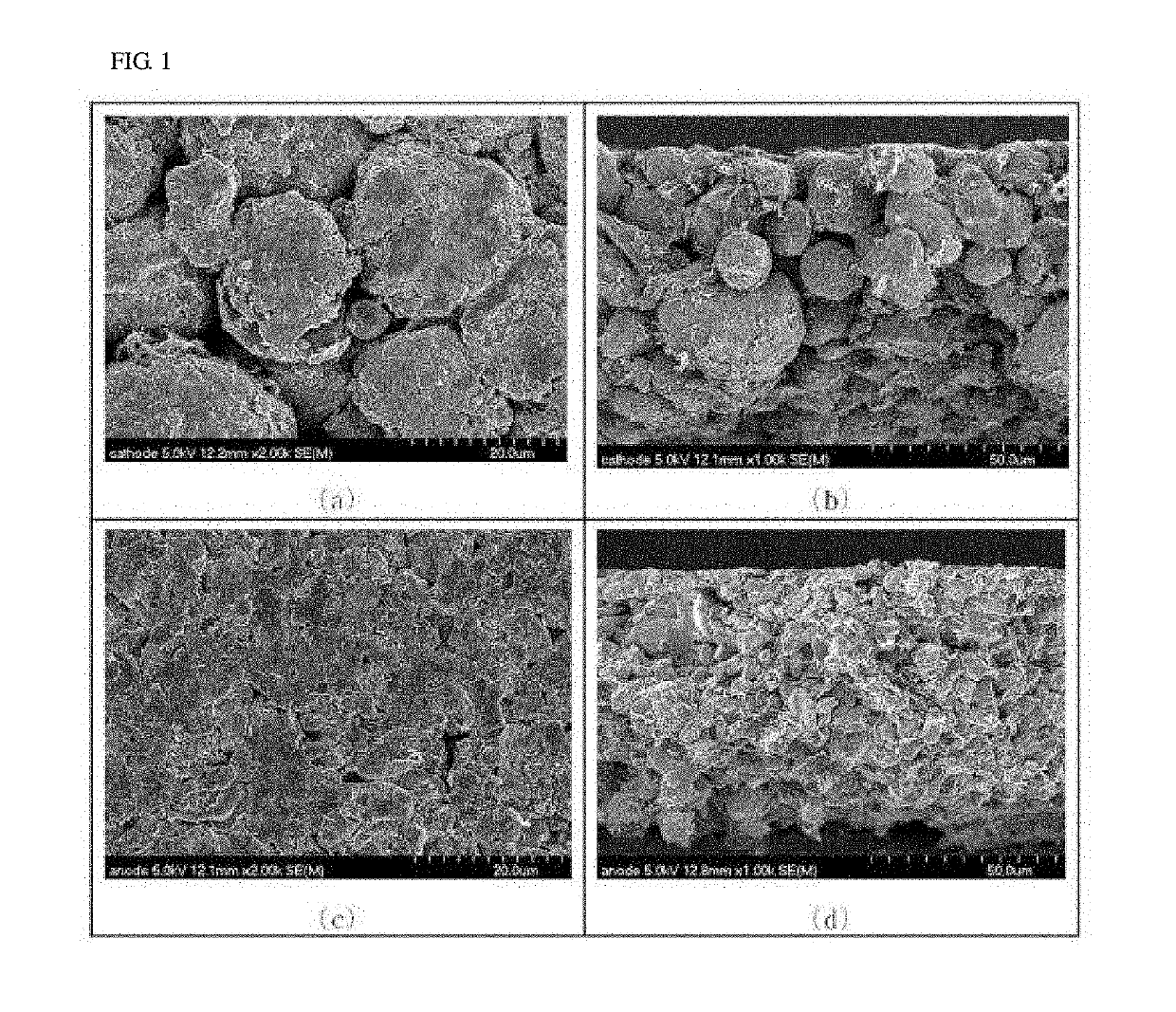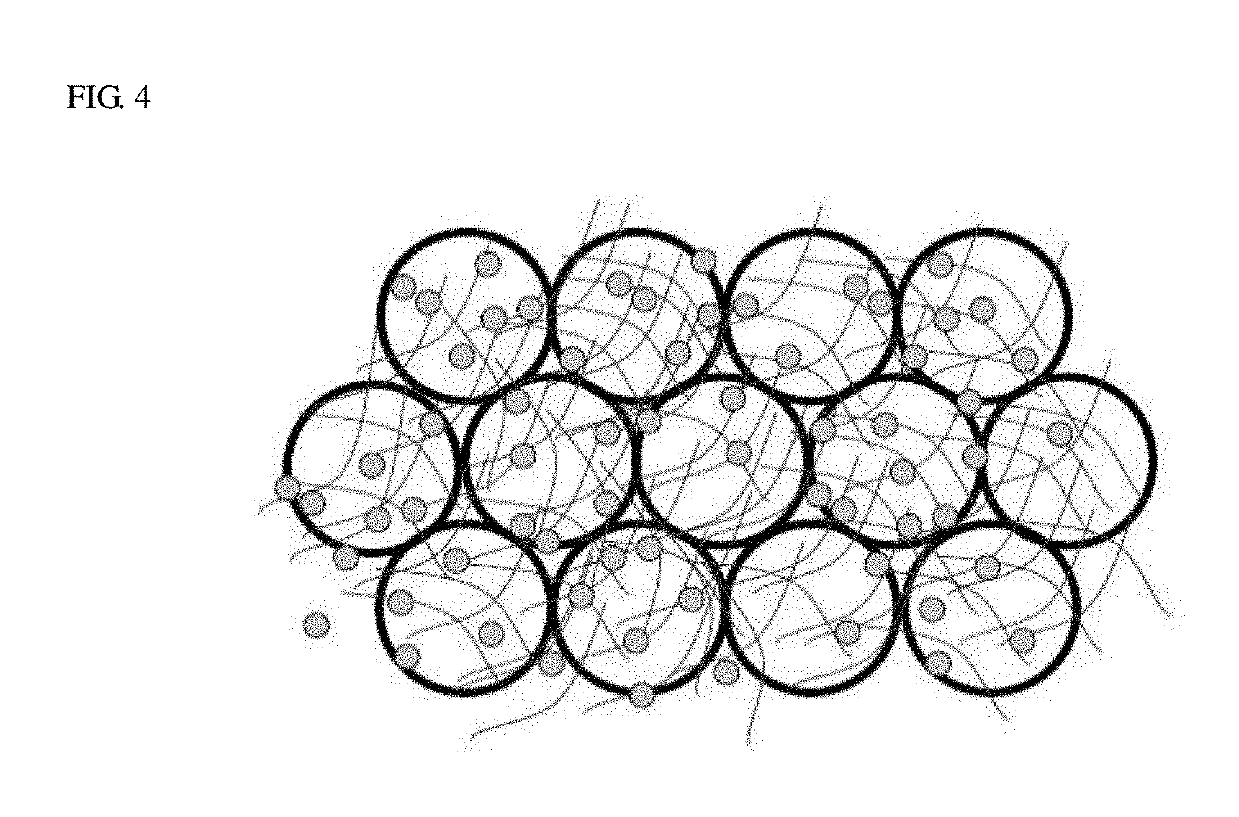Fabricating method of lithium electrode and lithium secondary battery including the same
a technology of lithium electrode and secondary battery, which is applied in the direction of electrode rolling/calendering, cell components, electrical equipment, etc., can solve the problems of reducing electronic conductivity, increasing resistance, and deteriorating use rate of electrodes, so as to prevent the breakage of active materials, maintain electronic conductivity, and excellent long-lasting charge and discharge characteristics
- Summary
- Abstract
- Description
- Claims
- Application Information
AI Technical Summary
Benefits of technology
Problems solved by technology
Method used
Image
Examples
example 1
[EXAMPLE 1] FABRICATION OF LITHIUM CATHODE
[0079]1. Preparation of Slurry Including Cathode Active Material and Formation of Cathode Active Material Layer
[0080]A slurry having a final solid content of 65% was prepared by mixing 94% LiCoO2, 3% acetylene black, 3% polyvinylidene fluoride, and N-methyl-2-pyrrolidone.
[0081]The slurry was coated on an aluminum foil having a thickness of 15 μm at a coating thickness of 90 μm by casting, followed by drying at 140° C. for 20 minutes, thereby forming a cathode active material layer.
[0082]2. Preparation of Slurry Including Fibrous Conductive Material and Formation of Conductive Fiber Structure Layer
[0083]In order to form a frame layer including a conductive fiber structure on a surface of the cathode active material layer formed as above, a slurry including a fibrous conductive material was prepared. The slurry including a fibrous conductive material was prepared by mixing 94% carbon nanofiber (average diameter of 100 nm, average length of 50 ...
example 2
[EXAMPLE 2] FABRICATION OF LITHIUM ANODE
[0086]1. Preparation of Slurry Including Anode Active Material and Formation of Anode Active Material Layer
[0087]A slurry including an anode active material having a final solid content of 45% was prepared by mixing 96% graphite, 4% polyvinylidene fluoride, and N-methyl-2-pyrrolidone.
[0088]The slurry was coated on a copper foil having a thickness of 12 μm at a coating thickness of 70 μm by casting, followed by drying at 140° C. for 20 minutes, thereby forming an anode active material layer.
[0089]2. Preparation of Slurry Including Fibrous Conductive Material and Formation of Conductive Fiber Structure Layer
[0090]In order to form a frame layer including a conductive fiber structure on a surface of the anode active material layer formed as above, a slurry including a fibrous conductive material was prepared. The slurry including a fibrous conductive material was prepared by mixing 94% carbon nanofiber (average diameter of 100 nm, average length o...
example 3
[EXAMPLE 3] FABRICATION OF LITHIUM SECONDARY BATTERY CELL
[0093]A lithium secondary battery cell was fabricated by stacking the lithium cathode of Example 1, a separator (Celgard) #2400), the lithium anode of Example 2, and injecting a solution of PC:EMC (volume ratio of 1:1) in which 1M LiPF6 is dissolved thereinto, followed by sealing.
PUM
| Property | Measurement | Unit |
|---|---|---|
| length | aaaaa | aaaaa |
| diameter | aaaaa | aaaaa |
| thickness | aaaaa | aaaaa |
Abstract
Description
Claims
Application Information
 Login to View More
Login to View More - R&D
- Intellectual Property
- Life Sciences
- Materials
- Tech Scout
- Unparalleled Data Quality
- Higher Quality Content
- 60% Fewer Hallucinations
Browse by: Latest US Patents, China's latest patents, Technical Efficacy Thesaurus, Application Domain, Technology Topic, Popular Technical Reports.
© 2025 PatSnap. All rights reserved.Legal|Privacy policy|Modern Slavery Act Transparency Statement|Sitemap|About US| Contact US: help@patsnap.com



